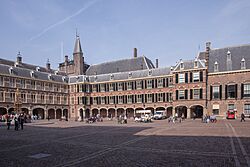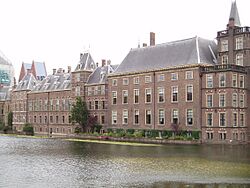Senate (Netherlands) facts for kids
Quick facts for kids SenateEerste Kamer der Staten-Generaal |
|
|---|---|
| States General of the Netherlands | |
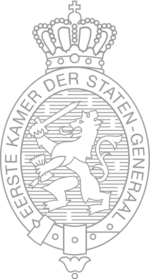 |
|
| Type | |
| Type | |
| Leadership | |
|
First Vice President
|
Mei Li Vos, GL–PvdA
Since 4 July 2023 |
|
Second Vice President
|
Robert Croll, D66
Since 4 July 2023 |
| Structure | |
| Seats | 75 |
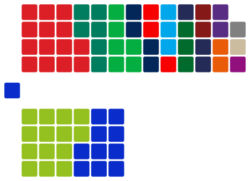 |
|
|
Political groups
|
Government (demissionary) (24)
Opposition (51) |
|
Length of term
|
4 years |
| Elections | |
| Indirect party-list proportional | |
|
Last election
|
30 May 2023 |
|
Next election
|
May 2027 |
| Meeting place | |
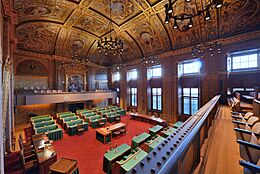 |
|
| Plenary Hall of the Senate, Binnenhof, The Hague (closed due to ongoing renovations) |
|
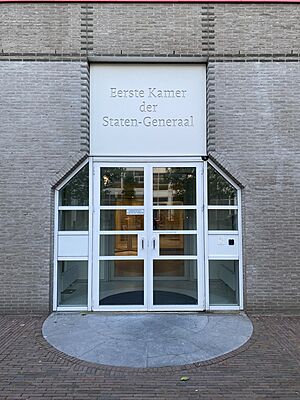 |
|
| Kazernestraat 52 (temporary) |
|
The Senate is one of the two parts of the Dutch parliament, which is called the States General. The other part is the House of Representatives. The Senate is known as the upper house, and its official Dutch name is the Eerste Kamer, which means "First Chamber."
The Senate has 75 members, called senators. They are not chosen directly by the people in a national election. Instead, they are elected every four years by members of the twelve provincial governments and special electoral colleges. This is called an indirect election.
Senators are often experienced politicians who may have other jobs. Their role is to carefully check new laws that have been passed by the House of Representatives. They meet once a week to do this work.
Contents
What Does the Senate Do?
The main job of the Senate is to be a "chamber of reflection." This means senators take a final look at new laws before they are official.
When the House of Representatives passes a new law (called a bill), it goes to the Senate. A small group of senators, called a committee, studies the bill. They check if it is well-written, if it follows the constitution, and if it will work as planned.
The committee then decides what to do next.
- If the bill is simple and everyone agrees, it can be passed quickly without a big discussion.
- If the bill is complicated or controversial, the senators will study it more and have a debate.
The Senate can only do two things with a bill: accept it or reject it. Unlike the House of Representatives, the Senate cannot change or amend the bill. If they reject it, the bill does not become a law.
History of the Senate
The Netherlands has not always had a Senate. The first constitution in 1814 created a parliament with only one chamber. But in 1815, when the Netherlands and Belgium joined together, a new constitution was written. Leaders from the south (now Belgium) wanted a second chamber to represent the nobility.
The new Senate was created with members appointed by the king for life. In the beginning, it was seen as a way for the king to control the lawmaking process. Senators were often friends of the king who would block laws he did not like.
Changes in 1848
A major change happened with the Constitutional Reform of 1848. This reform introduced direct elections for the House of Representatives. The plan was to have direct elections for the Senate too, but this was rejected. People worried that the two chambers would be too similar.
Instead, it was decided that senators would be elected by the members of provincial councils. This was meant to make the Senate more independent and focused on the quality of laws, rather than daily politics.
Modern Reforms
Over the years, the Senate has continued to change.
- In 1922, the election system was updated to use party-list proportional representation, making it fairer.
- In 1956, the number of senators was increased from 50 to 75.
- In 1983, the term for senators was shortened from six years to four years, the same as the House of Representatives.
Today, the Senate is an important part of the Dutch government, providing a final check on all new laws.
How Are Senators Elected?
The 75 senators are elected every four years by politicians who have already been elected to local governments. These voters are the members of the twelve States-Provincial (the governments of each province) and special electoral colleges for Dutch citizens living abroad and in the Caribbean Netherlands.
Weighted Voting
Not every voter has the same power. The vote of a politician from a province with a large population is worth more than a vote from a politician in a less populated province. This is called weighted voting. It ensures that provinces with more people have a bigger say in who becomes a senator.
For example, a vote from a member of the South Holland provincial council is worth much more than a vote from a member of the Zeeland council, because South Holland has many more residents.
The table below shows how much votes were worth in the 2019 election. The "Value per member" shows how powerful each vote was.
| Province/Special municipality | Members | Population | Value per member |
|---|---|---|---|
| South Holland | 55 | 3,674,146 | 668 |
| North Holland | 55 | 2,853,488 | 519 |
| North Brabant | 55 | 2,544,995 | 463 |
| Gelderland | 55 | 2,071,913 | 377 |
| Utrecht | 49 | 1,342,194 | 274 |
| Overijssel | 47 | 1,156,373 | 246 |
| Limburg | 47 | 1,116,127 | 237 |
| Friesland | 43 | 647,740 | 151 |
| Groningen | 43 | 584,094 | 136 |
| Drenthe | 41 | 492,179 | 120 |
| Flevoland | 41 | 416,431 | 102 |
| Zeeland | 39 | 383,073 | 98 |
| Bonaire | 9 | 20,104 | 22 |
| Sint Eustatius | 5 | 3,138 | 6 |
| Saba | 5 | 1,915 | 4 |
Political Groups in the Senate
Senators from the same political party work together in groups. Each group has a leader who speaks for them. This table shows the different political groups in the Senate and how many seats they have.
| Group | Leader | Seats | |
|---|---|---|---|
| Farmer–Citizen Movement | Ilona Lagas |
|
|
| GroenLinks–PvdA | Paul Rosenmöller |
|
|
| People's Party for Freedom and Democracy | Tanja Klip-Martin |
|
|
| Christian Democratic Appeal | Theo Bovens |
|
|
| Democrats 66 | Paul van Meenen |
|
|
| Party for Freedom | Alexander van Hattem |
|
|
| Party for the Animals | Niko Koffeman |
|
|
| JA21 | Annabel Nanninga |
|
|
| Socialist Party | Tiny Kox |
|
|
| Christian Union | Tineke Huizinga |
|
|
| Forum for Democracy | Johan Dessing |
|
|
| Volt Netherlands | Gaby Perin-Gopie |
|
|
| Reformed Political Party | Peter Schalk |
|
|
| 50PLUS | Martin van Rooijen |
|
|
| Independent Politics Netherlands | Auke van der Goot |
|
|
| Kemperman group | Eric Kemperman |
|
|
See also
 In Spanish: Senado de los Estados Generales para niños
In Spanish: Senado de los Estados Generales para niños
- List of presidents of the Senate (Netherlands)


